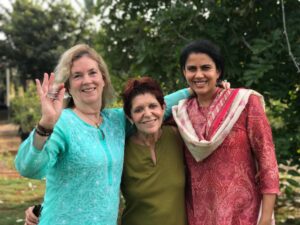24 hour dance-a-thon fundraiser for Covid-19
Dance teachers from around the world are coming together to help raise funds for Covid-19. M-DO Kathak Toronto, a renowned Kathak dance institute, has joined hands with Chhandika, Boston and Chhandam Nritya Bharati, Mumbai and presenting an international dance-a-thon (in Kathak) to support Covid aid for India. This 24-hour non-stop dance marathon was supported by more than 1000 participating dancers and 24 session leaders. It created a wealth of dance content, shared an incredible breadth of experience, and extended the usual zoom platform energy exponentially. I spoke with the organiser Joanna de Souza, founder and director, M-Do Kathak Toronto and this is what she said excitedly.
Tell us more about your organisation.
M-DO is been a registered charitable organisation, in good standing with Revenue Canada, since 1988. The dance/ education organisation takes its name from the Tibetan word (Hmdo) for meeting point, and is a place where cultures come together, traditions are honoured, and new creative ideas are born. Supported by our informed teachers and facilitators, we offer artistically rich kathak dance classes, workshops, and performances that contribute to a vibrant arts community, locally, nationally and internationally. Over a 25 year period, we have maintained dedicated studio spaces in downtown Toronto that not only supported our work, but acted a hub for other artists and groups to teach, create, rehearse and present their works.
How did the idea of a 24 hour dance-a-thon come about?
Jane Morris, a long-time member of our dance community, came up with the idea, as a means of giving back to the country (India) which has given us all the art form we love so much (Kathak) Collectively we Decided on the name Rhythm for Life. That is when we contacted our other friends from the Kathak world and decided to do this together.

What went into preparing for this interesting event?
We spread the word and the call for dancers to get sponsors via our zoom kathak classes, and all possible social media platforms. We simply created google docs to allow people to sign up for specific dance times (1 hour slots) and to state if they wished to be session leaders. Through our very competent team, we produced all the written material to spread the word, researched NGOs to select donation organisations, and manifested all the necessary backend protocols which allowed us to track donations and to track those who sponsored specific dancers. We had a team who researched and facilitated the necessary full support for each leader (with the zoom limitations of audio), and supported the live streaming aspect on Facebook. (Challenging for 24 hours as is all had to reset every 8 hours creating new links that needed to be made available to all who wished to watch it live).
What challenges did you face to prepare for this dance-a-thon?
Our team was as prepared as we could be and it ran seamlessly, but the challenges of whether or not we could actually make it all work – particularly the Facebook live stream and having everything running live in real time, was a bit stressful. Other big challenge was the different time zones that we were working with Canada, India and The United States of America., so the planning of the 24 hour workshop had to be monitored.
Is there a particular Covid-19 charity you supported? If so, why did you choose it?
We are a charitable arts organisation based in Toronto, Canada, and as such have had experience with CanadaHelps.org. It is an umbrella organisation that supports charities. Through them, there were about six smaller organizations working on the ground in India to support everything from supplying PPE to oxygen to food, to aiding children and women. Donors were able to choose the small organisation of their choice to donate directly. We also chose MSF (medicines sans frontiers) Doctors without borders, as they do amazing work. All of their charities take a very small percentage (around 5%) of their donations for their administrative costs- leaving 95% to go directly to the need, and they also issue their own tax receipts, a great incentive to those who are donating.
How was the response from dancers and dance teachers for the Dance-a-thon?
All of this for a cause: Art for Community – Art for Aid – Art for Beauty. Together they gathered more than $13,000 in donation pledges for a variety of NGO’s working on the ground. The response has been overwhelming and so the funding drive continues. This Dance-a-thon would not have been possible without the help of my two pillars Seema Mehta from Mumbai, India and Gretchen Hayden from Boston, USA. They along with other teachers really worked hard to put it all together. I must name all the teachers who led the dance sessions for participants and danced one after the other for 24 hours. The Dance-a-thon began with my session after which Gretchen Hayden took a session and then was Jane Morris, followed by Kiran Phull, TP Chai, Seema Mehta, Shefali Jain, Ameera Nimjee, Sucheta Heble, Meenakshi Aggarwal, Keya B. Waikar, Prajakta Dravid, Anita Katakkar, Cathryn Wright, Sujatha Kumar, Sudeshna Maulik, Purvi Patel, Urvashi Batra, Natasha Manji and Aarti Anand. Through you I want to wish to show my gratitude to them all.
Are you planning more such fundraisers?
No plans at the moment, but, on an ad hoc basis we do fundraise as the need arises. Our organisation has also created DirectAid in support of a small village in Sri Lanka after the tsunami had hit the country. We are artistes who just respond to need as we can.